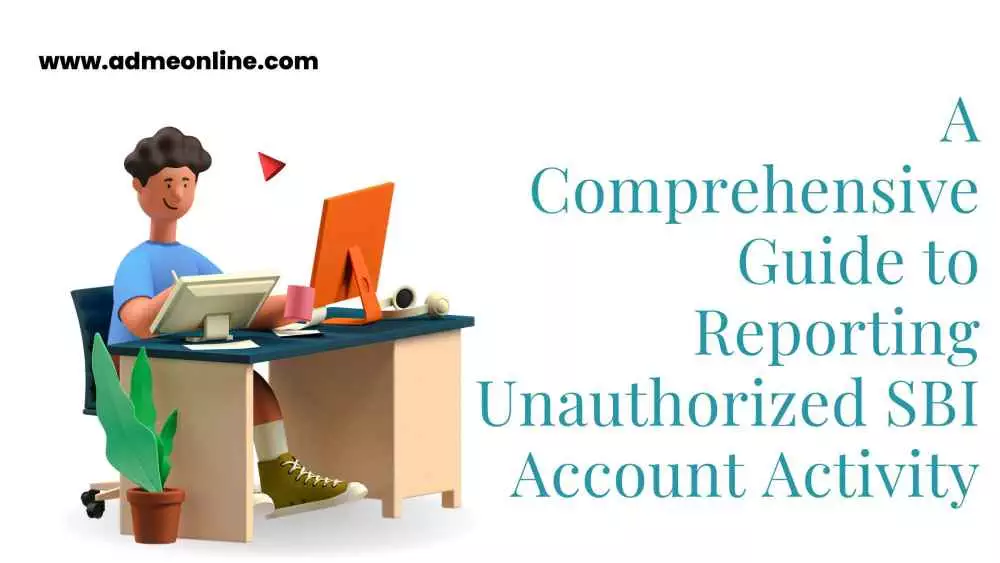
In an age of digital transactions, safeguarding your financial assets is paramount. Unfortunately, unauthorized transactions can occur, and when they do, it’s essential to take swift action.
Welcome to our guide on SBI Unauthorized Transaction Complaint, where we’ll walk you through the process of reporting and resolving unauthorized transactions. We’ll address various channels, including online reporting, email, and more, to ensure your SBI account remains secure.
SBI Unauthorized Transaction Complaint: Reporting and Resolving
| Contact Information | Immediate Actions |
|---|---|
| SBI Customer Care Helpline Numbers | 1800-425-3800, 1800-11-11-09, 1800-11-22-11 These numbers offer immediate assistance in reporting unauthorized transactions. |
| SBI Unauthorized Transaction Complaint Email | Email Address: [email protected] Send an email to report unauthorized transactions. |
| Online Reporting Link | Report unauthorized transactions online quickly here: SBI Unauthorized Transaction Reporting |
Understanding Unauthorized Transactions
Unauthorized transactions involve any financial activity on your SBI account that you did not authorize. These can range from online purchases to fund transfers without your knowledge or consent. Failing to address these promptly can lead to financial losses and security risks.
In this comprehensive guide, we will walk you through the step-by-step process of reporting unauthorized transactions and the different options available.
We’ll also provide you with additional information about SBI’s unauthorised transaction complaint mail ID, letter format, cybercrime complaint number, and checking the complaint status.
How to Detect Unauthorized Transactions
To protect your account, it’s essential to know the signs of unauthorized transactions. Keep a close eye on your transaction history, and be wary of unfamiliar or suspicious activities. Regularly monitoring your SBI account will help you detect unauthorized transactions early.
Reporting Unauthorized Transactions in SBI Account
Reporting unauthorized transactions is a crucial step. You have several options, including online reporting, emailing SBI, or visiting a branch. Here’s how you can report unauthorized transactions through these channels:
- Online Banking and SBI YONO App: Log in to your account, navigate to the “Report Unauthorized Transaction” section, and follow the provided instructions.
- Customer Care Helpline: Call SBI’s toll-free customer care numbers (1800 11 11 09, 1800 11 22 11, 1800 425 3800).
- Email: Send an email to SBI’s designated email address for unauthorized transaction complaints, including all necessary transaction details. (Send mail to: [email protected])
- Visiting an SBI Branch: Visit your nearest SBI branch and provide details of the unauthorized transaction to a bank representative.
Use any of the below options to Report Unauthorized Transactions in your SBI Account.
Option 1: Reporting Unauthorized Transactions Through SBI Online Banking
Step 1: Log in to your SBI Online Banking account.
Step 2: Navigate to the “Report Unauthorized Transaction” section, typically found under “Customer Services” or “Manage Accounts.”
Step 3: Provide the transaction details, including the date, amount, and transaction reference number (if available).
Step 4: Select the unauthorized transaction and follow the on-screen instructions to report it. You might be required to fill out a dispute form.
Step 5: Confirm the submission, and SBI’s customer support will initiate the investigation. You can check the complaint status at a later stage.
You can also report the unauthorised transaction in your SBI Account here: https://crcf.sbi.co.in/ccf/home/UnAuth/
Option 2: Contacting SBI Customer Care
Step 1: Call SBI’s 24/7 customer care helpline at the toll-free number: 1800-425-3800.
Step 2: Follow the automated menu or speak to a customer care representative.
Step 3: Explain the unauthorized transaction, providing all necessary details, such as the transaction date, amount, and reference number.
Step 4: The customer care team will guide you on the next steps and initiate the investigation.
Option 3: Visiting an SBI Branch
Step 1: Locate the nearest SBI branch.
Step 2: Visit the branch in person.
Step 3: Inform the bank officials about the unauthorized transaction.
Step 4: Provide the transaction details and any supporting documentation.
Step 5: The bank officials will assist you in filling out a dispute form.
Step 6: The branch will initiate the investigation, and you will be updated on the progress.
Option 4: Using the SBI YONO App
Step 1: Open the SBI YONO app and log in to your account.
Step 2: Navigate to the “Report Unauthorized Transaction” section.
Step 3: Enter the transaction details, including date, amount, and reference number.
Step 4: Select the unauthorized transaction and follow the prompts to report it.
Step 5: Confirm the submission, and the bank will investigate the matter.
Option 5: Send an Email
Step 1: Compose an email to SBI’s designated email address for reporting unauthorized transactions ([email protected]). You can find the SBI Unauthorized Transaction Complaint Letter format in PDF here.
Step 2: Include all transaction details and your account information.
Step 3: Clearly state that you are reporting an unauthorized transaction and request assistance.
Step 4: SBI’s customer support will respond to your email and guide you through the process.
Note: You can directly send the mail from here: https://crcf.sbi.co.in/ccf/
Does SBI Refund Unauthorised Transaction?
Yes, SBI does offer the possibility of a refund for unauthorized transactions. To initiate the refund process, you should report the unauthorized transaction to SBI as soon as you detect it. Use the contact channels provided in the blog post, such as calling the customer care helpline, reporting online, or sending an email to SBI’s designated address.
The bank will investigate the matter, and if the transaction is confirmed as unauthorized, they will take appropriate actions, which may include refunding the disputed amount. It’s essential to report unauthorized transactions promptly to increase the chances of a successful refund.
Tips for Preventing Unauthorized Transactions:
In a world where digital transactions have become the norm, ensuring the security of your SBI account is paramount. To help you safeguard your account and prevent unauthorized transactions, we’ve compiled some practical advice:
1. Secure Login Credentials:
Your login credentials are the keys to your SBI account. Protect them with the utmost care. Here’s how:
- Create Strong Passwords: Design strong, unique passwords that combine letters, numbers, and symbols. Avoid easily guessable information like birthdays or names.
- Change Passwords Regularly: Periodically change your passwords, and avoid using the same one for multiple accounts.
- Enable Two-Factor Authentication (2FA): SBI offers 2FA as an extra layer of security. Activate it to enhance your account’s protection.
- Beware of Phishing Attempts: Be cautious of unsolicited emails, messages, or calls requesting your login information. SBI will never ask for your details through these means.
2. Setting Up Transaction Alerts:
Transaction alerts are your early warning system against unauthorized activity. Take these steps:
- Enable Transaction Alerts: Set up alerts for all transactions on your SBI account, including balance changes, withdrawals, and transfers.
- Customize Alert Thresholds: Tailor your alerts to your financial habits. Choose the transaction amount that triggers an alert, ensuring you’re promptly notified of any unusual activity.
- Regularly Review Alerts: Pay close attention to your transaction alerts. If you receive an alert for a transaction you didn’t authorize, take immediate action by reporting it to SBI.
3. Regularly Updating Contact Information:
Keeping your contact information up-to-date is essential for efficient communication with SBI and timely security alerts.
- Update Your Mobile Number: Ensure your registered mobile number is current, as SBI often uses it for one-time passwords (OTPs) and communication.
- Maintain a Valid Email Address: Similarly, your email address should be active and accessible. SBI may use it for account-related notifications.
- Check Your Postal Address: If you’ve moved or your postal address has changed, update it with SBI to receive important account statements and correspondence.
By following these practical tips, you can significantly reduce the risk of unauthorized transactions in your SBI account. Protecting your login credentials, staying alert to transaction activity, and ensuring your contact information is accurate are essential steps in maintaining the security of your financial assets.
Conclusion: SBI prioritizes the security and satisfaction of its customers, and reporting unauthorized transactions is an essential part of this commitment. By following one of the options outlined in this guide, you can take swift action to protect your account and ensure that unauthorized transactions are thoroughly investigated and resolved. Remember, prompt reporting is crucial in such situations, so do not hesitate to reach out to SBI as soon as you detect any unauthorized activity in your account.
Frequently Asked Questions Related to Reporting Unauthorized Transactions in SBI Account:
What should I do if I notice an unauthorized transaction in my SBI account?
If you spot an unauthorized transaction, report it immediately to SBI through their customer service channels. This includes using online banking, calling customer care (1800 11 11 09, 1800 11 22 11, 1800 425 3800), or visiting a branch.
What information do I need to provide when reporting an unauthorized transaction?
You should provide details such as the transaction date, amount, and, if available, the transaction reference number. Additionally, explain that you did not authorize the transaction.
How can I report an unauthorized transaction online through SBI’s digital channels?
You can report an unauthorized transaction through SBI Online Banking or the SBI YONO app by navigating to the “Report Unauthorized Transaction” section and following the instructions. You can report unauthorized transactions online quickly here: https://crcf.sbi.co.in/ccf/home/UnAuth/.
What is the process for reporting an unauthorized transaction through email to SBI?
Send an email to SBI’s designated email address for reporting unauthorized transactions ([email protected]). Include all transaction details and your account information, clearly stating that you’re reporting an unauthorized transaction.
How can I check the status of my unauthorized transaction complaint with SBI?
You can check the status of your complaint by following up with the channel you used to report it. Typically, SBI will provide updates through the same communication method you used to lodge your complaint.

